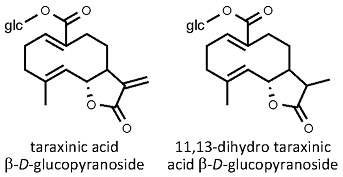 Taraxacum officinale
Taraxacum officinale
dandelion
Back to “Salad herbs and herb mixtures: dandelion (Taraxacum officinale)”
Back to “Culinary herbs: dandelion (Taraxacum officinale)”
Taraxacum officinale Weber ex Wigg. (Asteraceae); perdeblom (Afrikaans); pu gong ying (Chinese); pissenlit (French); Löwenzahn (German); taraxaco (Italian); diente de león (Spanish)
DESCRIPTION Freshly picked leaves are bright green, oblong in shape, irregularly toothed along the margin and have milky latex exuding from the midrib. They have a bitter, chicory-like flavour.
THE PLANT A common, weedy herb with a rosette of oblong, markedly toothed leaves and solitary, yellow flower heads borne on slender, unbranched, hollow stalks. The small fruits are wind-dispersed. Dandelion is considered to represent several hundreds of cryptic species, but they are usually collectively referred to as T. officinale in the broad sense.1 Several relatives of the Asteraceae, all with milky latex, are used as salad herbs. These include lettuce, endive and sow thistle (see section on Salad herbs).
ORIGIN Originally Europe and Asia, but now a cosmopolitan weed, present in the United States, Australia and all other temperate parts of the world.1 The roots were once dried and roasted to make a caffeine-free coffee substitute in much the same way as chicory drinks are made from the roots of Cichorium intybus.2,3 The leaves have probably been eaten as a potherb and wild salad for centuries.3 The popularity of dandelion is reflected in the large number of English common names that have been recorded, often referring to its alleged diuretic activity.
CULTIVATION Dandelion is usually propagated by seeds, sown in pots in early spring, but it can easily be grown from root cuttings as well. Flower heads should be removed to prevent the seeds from spreading all over the garden. Most people would be more interested in learning how to contain or get rid of dandelion than how to grow it! Wild-harvesting is possible in rural areas, but modern cultivars are available to grow as salad herbs. These have larger leaves with margins variously crisped or curled.2 The leaves may be blanched by covering the plants with straw or plastic sheeting.2,3 Dandelion is grown commercially to a limited extent in southern Europe (France and Italy).3
HARVESTING Leaves can be picked throughout the season but those harvested before flowering are considered to be the best.4
CULINARY USES Young leaves are eaten raw in fresh salads and are appreciated for their refreshing bitter taste (similar to lettuce or endive). In French cuisine, dandelion salad often contains garlic-flavoured croutons, pieces of bacon, walnuts and hard-boiled egg (e.g. salade de groin d’âne).4 Young leaves are stir-fried in China. Dandelion also has other culinary uses. The leaves can be eaten as a green vegetable and cooked like spinach.4 Open flower heads are traditionally dried and used to make dandelion wine.2,3
FLAVOUR COMPOUNDS The bitter taste of dandelion leaves (and roots) is due to the presence of sesquiterpenes (mainly taraxinic acid β-D-glucopyranoside and 11,13-dihydro taraxinic acid β-D-glucopyranoside), as well as p-hydroxy phenyl acetic acid and β-sitosterol.5

NOTES The typical toothed leaf margins probably gave rise to the English name “dandelion”, derived from the French dent-de-lion (“lion’s tooth”).4
1. Mabberley, D.J. 2008. Mabberley’s plant-book (3rd ed.). Cambridge University Press, Cambridge.
2. Vaughan, J.G., Geissler, C.A. 1997. The New Oxford Book of Food Plants. Oxford University Press, Oxford.
3. Kiple, K.F., Ornelas, K.C. (Eds). 2000. The Cambridge world history of food. Cambridge University Press, Cambridge.
4. Larousse. 1999. The concise Larousse gastronomique. Hamlyn, London.
5. Kuusi, T., Pyysalo, H., Autio, K., 1985. The bitterness properties of dandelion. II. Chemical investigations. Lebensmittel-Wissenschaft und Technologie 18: 347–349.